Molecular Cloning, Bioinformatics, and Expression Analysis of the NPR1 Homolog in Sesame (Sesamum indicum L.)
Abstract
1. Introduction
2. Results
2.1. BTH Elicitation on the Inhibition of Ralstonia Solanacearum Infection in Sesame
2.2. Gene Cloning and Sequence Analysis of SiNPR1
2.3. Structural Analysis of the SiNPR1 Protein
2.4. Phylogenetic Analysis of the SiNPR1 Protein
2.5. Subcellular Localization of the SiNPR1 Protein
2.6. Cis-Elements Analysis of the SiNPR1 Promoter
2.7. Expression Profile of SiNPR1 in Various Organs and in Response to BTH Treatments
2.8. SiNPR1 Could Interact with SiTGA2
3. Discussion
4. Materials and Methods
4.1. Plant Materials
4.2. Methods
4.2.1. RNA Extraction and qRT-PCR Analysis
4.2.2. Cloning of SiNPR1 Gene Sequence
4.2.3. Cloning of SiNPR1 Promoter
4.2.4. Sequence Analysis and Gene Cloning of SiTGA2
4.2.5. Bioinformatics Analysis
4.2.6. Subcellular Localization
4.2.7. Yeast Two-Hybrid (Y2H) Assays
4.2.8. Statistical Analysis
5. Conclusions
Supplementary Materials
Author Contributions
Funding
Data Availability Statement
Conflicts of Interest
References
- Pieterse, C.M.J.; Leon-Reyes, A.; Sjoerd, V.D.E.; Van Wees, S.C.M. Networking by small-molecule hormones in plant immunity. Nat. Chem. Biol. 2009, 5, 308–316. [Google Scholar] [CrossRef]
- An, C.; Mou, Z. Salicylic acid and its function in plant immunity. J. Integr. Plant Biol. 2011, 53, 412–428. [Google Scholar] [CrossRef]
- Fu, Z.Q.; Dong, X. Systemic acquired resistance: Turning local infection into global defense. Annu. Rev. Plant Biol. 2013, 64, 839–863. [Google Scholar] [CrossRef] [PubMed]
- David, L.; Harmon, A.C.; Chen, S. Plant immune responses-from guard cells and local responses to systemic defense against bacterial pathogens. Plant Signal. Behav. 2019, 14, e1588667. [Google Scholar] [CrossRef]
- Kim, T.J.; Lim, G.H. Salicylic acid and mobile regulators of systemic immunity in plants: Transport and metabolism. Plants 2023, 12, 1013. [Google Scholar] [CrossRef] [PubMed]
- Shine, M.; Xiao, X.; Kachroo, P.; Kachroo, A. Signaling mechanisms underlying systemic acquired resistance to microbial pathogens. Plant Sci. 2019, 279, 81–86. [Google Scholar] [CrossRef]
- Durrant, W.E.; Dong, X. Systemic acquired resistance. Annu. Rev. Phytopathol. 2004, 42, 185–209. [Google Scholar] [CrossRef]
- Yoshioka, K.; Nakashita, H.; Klessig, D.F.; Yamaguchi, I. Probenazole induces systemic acquired resistance in Arabidopsis with a novel type of action. Plant J. 2001, 25, 149–157. [Google Scholar] [CrossRef] [PubMed]
- Durner, J.; Klessig, D.F. Inhibition of ascorbate peroxidase by salicylic acid and 2,6-dichloroisonicotinic acid, two inducers of plant defense responses. Proc. Natl. Acad. Sci. USA 1995, 92, 11312–11316. [Google Scholar] [CrossRef]
- Yalpani, N.; Raskin, I. Salicylic acid: A systemic signal in induced plant disease resistance. Trends Microbiol. 1993, 1, 88–92. [Google Scholar] [CrossRef]
- Cao, H.; Glazebrook, J.; Clarke, J.D.; Volko, S.; Dong, X. The Arabidopsis NPR1 gene that controls systemic acquired resistance encodes a novel protein containing ankyrin repeats. Cell 1997, 88, 57–63. [Google Scholar] [CrossRef] [PubMed]
- Wang, W.; Withers, J.; Li, H.; Zwack, P.J.; Rusnac, D.V.; Shi, H.; Liu, L.; Yan, S.; Hinds, T.R.; Guttman, M.; et al. Structural basis of salicylic acid perception by Arabidopsis NPR proteins. Nature 2020, 586, 311–316. [Google Scholar] [CrossRef]
- Seo, S.; Kim, Y.; Park, K. NPR1 Translocation from Chloroplast to Nucleus Activates Plant Tolerance to Salt Stress. Antioxidants 2023, 12, 1118. [Google Scholar] [CrossRef]
- Zavaliev, R.; Dong, X. NPR1, a key immune regulator for plant survival under biotic and abiotic stresses. Mol. Cell 2024, 84, 131–141. [Google Scholar] [CrossRef] [PubMed]
- Li, M.; Li, M.; Qi, S.; Wang, L.; Kim, C. Salicylic acid and ROS signaling modulate hypocotyl elongation in darkness via NPR1 and EX1. Sci. Adv. 2025, 11, eadx4417. [Google Scholar] [CrossRef]
- Eulgem, T.; Somssich, I.E. Networks of WRKY transcription factors in defense signaling. Curr. Opin. Plant Biol. 2007, 10, 366–371. [Google Scholar] [CrossRef]
- Rochon, A.; Boyle, P.; Wignes, T.; Fobert, P.R.; Despres, C. The coactivator function of Arabidopsis NPR1 requires the core of its BTB/POZ domain and the oxidation of C-terminal cysteines. Plant Cell 2006, 18, 3670–3685. [Google Scholar] [CrossRef]
- Fan, W.; Dong, X. In vivo interaction between NPR1 and transcription factor TGA2 leads to salicylic acid-mediated gene activation in Arabidopsis. Plant Cell 2002, 14, 1377–1389. [Google Scholar] [CrossRef]
- Sun, L.M.; Fang, J.B.; Zhang, M.; Qi, X.J.; Lin, M.M.; Chen, J.Y. Molecular cloning and functional analysis of the NPR1 homolog in kiwifruit (Actinidia eriantha). Front. Plant Sci. 2020, 11, 551201. [Google Scholar] [CrossRef]
- Chern, M.; Fitzgerald, H.A.; Canlas, P.E.; Navarre, D.A.; Ronald, P.C. Overexpression of a rice NPR1 homolog leads to constitutive activation of defense response and hypersensitivity to light. Mol. Plant Microbe Interact. 2005, 18, 511–520. [Google Scholar] [CrossRef] [PubMed]
- Liu, X.; Liu, Z.; Niu, X.; Xu, Q.; Yang, L. Genome-wide identification and analysis of the NPR1-like gene family in bread wheat and its relatives. Int. J. Mol. Sci. 2019, 20, 5974. [Google Scholar] [CrossRef]
- Maldonado, A.; Youssef, R.; McDonald, M.; Brewer, E.; Beard, H.; Matthews, B. Modification of the expression of two NPR1 suppressors, SNC1 and SNI1, in soybean confers partial resistance to the soybean cyst nematode, Heterodera glycines. Funct. Plant Biol. 2014, 41, 714–726. [Google Scholar] [CrossRef] [PubMed]
- Zhang, J.Y.; Qiao, Y.S.; Lv, D.; Gao, Z.H.; Qu, S.C.; Zhang, Z. Malus hupehensis NPR1 induces pathogenesis-related protein gene expression in transgenic tobacco. Plant Biol. 2012, 14, 46–56. [Google Scholar] [CrossRef] [PubMed]
- Yuan, Y.; Zhong, S.; Li, Q.; Zhu, Z.; Lou, Y.; Wang, L.; Wang, J.; Wang, M.; Li, Q.; Yang, D.; et al. Functional analysis of rice NPR1-like genes reveals that OsNPR1/NH1 is the rice orthologue conferring disease resistance with enhanced herbivore susceptibility. Plant Biotechnol. J. 2007, 5, 313–324. [Google Scholar] [CrossRef]
- Peng, A.; Zou, X.; He, Y.; Chen, S.; Liu, X.; Zhang, J.; Zhang, Q.; Xie, Z.; Long, J.; Zhao, X. Overexpressing a NPR1-like gene from Citrus paradisi enhanced Huanglongbing resistance in C. sinensis. Plant Cell Rep. 2021, 40, 529–541. [Google Scholar] [CrossRef]
- Zhang, J.; Jiao, P.; Zhang, C.; Tong, X.; Wei, Q.; Xu, L. Apple NPR1 homologs and their alternative splicing forms may contribute to SA and disease responses. Tree Genet. Genomes 2016, 12, 92. [Google Scholar] [CrossRef]
- Xing, L.; Gao, L.; Chen, Q.; Pei, H.; Wang, X. Over-expressing a UDP-glucosyltransferase gene (Ta-UGT3) enhances Fusarium Head Blight resistance of wheat. Plant Growth Regul. 2018, 84, 561–571. [Google Scholar] [CrossRef]
- Tada, Y.; Spoel, S.H.; Pajerowska-Mukhtar, K.; Mou, Z.; Song, J.; Wang, C.; Zuo, J.; Dong, X. Plant immunity requires conformational charges of NPR1 via S-nitrosylation and thioredoxins. Science 2008, 321, 952–956. [Google Scholar] [CrossRef]
- Angamuthu, M.; Govindasamy, S.; Kasirajan, S.; Langyan, S.; Rangan, P.; Pradheep, K. Origin and history of sesame and its uses. In Sesame: Sustainable Production and Applications; Springer: Singapore, 2025; pp. 1–19. [Google Scholar] [CrossRef]
- Rauf, S.; Basharat, T.; Gebeyehu, A.; Elsafy, M.; Rahmatov, M.; Ortiz, R.; Kaya, Y. Sesame, an underutilized oil seed crop: Breeding achievements and future challenges. Plants 2024, 13, 2662. [Google Scholar] [CrossRef]
- Zhang, H.; Langham, D.R.; Miao, H. Economic and academic importance of sesame. In The Sesame Genome; Springer: Cham, Swtizerland, 2021; pp. 1–18. [Google Scholar] [CrossRef]
- Wang, R.; Li, X.; Lv, F.; He, J.; Lv, R.; Wei, L. Sesame bacterial wilt significantly alters rhizosphere soil bacterial community structure, function, and metabolites in continuous cropping systems. Microbiol. Res. 2024, 282, 127649. [Google Scholar] [CrossRef] [PubMed]
- Li, L.; Rao, J.; Xiao, Y.; Wei, L.; Wang, R.; Huang, R.; Huang, R.; Hu, J.; Hua, J. Identification of resistance of sesame (Sesamum indicum) germplasm resources to bacterial wilt (Ralstorinia solanacearum). Acta Agric. Jiangxi 2018, 30, 54–58. [Google Scholar] [CrossRef]
- Li, X.; Huang, X.; Chen, G.; Zou, L.; Wei, L.; Hua, J. Complete genome sequence of the sesame pathogen Ralstonia solanacearum strain SEPPX 05. Genes Genom. 2018, 40, 657–668. [Google Scholar] [CrossRef]
- Friedrich, L.; Lawton, K.; Ruess, W.; Masner, P.; Specker, N.; Rella, M.G.; Meier, B.; Dincher, S.; Staub, T.; Uknes, S. A benzothiadiazole derivative induces systemic acquired resistance in tobacco. Plant J. 1996, 10, 61–70. [Google Scholar] [CrossRef]
- Bovie, C.; Ongena, M.; Thonart, P.; Dommes, J. Cloning and expression analysis of cDNAs corresponding to genes activated in cucumber showing systemic acquired resistance after BTH treatment. BMC Plant Biol. 2004, 4, 15. [Google Scholar] [CrossRef]
- Deng, H.; Ma, L.; Gong, D.; Xue, S.; Ackah, S.; Prusky, D.; Bi, Y. BTH-induced joint regulation of wound healing at the wounds of apple fruit by JA and its downstream transcription factors. Food Chem. 2023, 410, 135184. [Google Scholar] [CrossRef] [PubMed]
- Li, H.; Wu, J.; Shang, X.; Geng, M.; Gao, J.; Zhao, S.; Yu, X.; Liu, D.; Kang, Z.; Wang, X. WRKY transcription factors shared by BTH-induced resistance and NPR1-mediated acquired resistance improve broad-spectrum disease resistance in wheat. Mol. Plant Microbe Interact. 2020, 33, 433–443. [Google Scholar] [CrossRef]
- Ding, Y.; Sun, T.; Ao, K.; Peng, Y.; Zhang, Y.; Li, X.; Zhang, Y. Opposite roles of salicylic acid receptors NPR1 and NPR3/NPR4 in transcriptional regulation of plant immunity. Cell 2018, 173, 1454–1467. [Google Scholar] [CrossRef] [PubMed]
- Zhang, Y.; Fan, W.; Kinkema, M.; Li, X.; Dong, X. Interaction of NPR1 with basic leucine zipper protein transcription factors that bind sequences required for salicylic acid induction of the PR-1 gene. Proc. Natl. Acad. Sci. USA 1999, 96, 6523–6528. [Google Scholar] [CrossRef] [PubMed]
- Boyle, P.; Le Su, E.; Rochon, A.; Shearer, H.L.; Murmu, J.; Chu, J.Y.; Fobert, P.R.; Despres, C. The BTB/POZ domain of the Arabidopsis disease resistance protein NPR1 interacts with the repression domain of TGA2 to negate its function. Plant Cell 2009, 21, 3700–3713. [Google Scholar] [CrossRef]
- Johnson, C.; Mhatre, A.; Arias, J. NPR1 preferentially binds to the DNA-inactive form of Arabidopsis TGA2. Biochim. Biophys. Acta 2008, 1779, 583–589. [Google Scholar] [CrossRef]
- Mou, Z.; Fan, W.; Dong, X. Inducers of plant systemic acquired resistance regulate NPR1 function through redox changes. Cell 2003, 113, 935–944. [Google Scholar] [CrossRef]
- Le Henanff, G.; Heitz, T.; Mestre, P.; Mutterer, J.; Walter, B.; Chong, J. Characterization of Vitis vinifera NPR1 homologs involved in the regulation of pathogenesis-related gene expression. BMC Plant Biol. 2009, 9, 54. [Google Scholar] [CrossRef]
- Zang, S.; Qin, L.; Zhao, Z.; Zhang, J.; Zou, W.; Wang, D.; Feng, A.; Yang, S.; Que, Y.; Su, Y. Characterization and functional implications of the Nonexpressor of Pathogenesis-Related genes 1 (NPR1) in Saccharum. Int. J. Mol. Sci. 2022, 23, 7984. [Google Scholar] [CrossRef]
- Zhong, X.; Xi, L.; Lian, Q.; Luo, X.; Wu, Z.; Seng, S.; Yuan, X.; Yi, M. The NPR1 homolog GhNPR1 plays an important role in the defense response of Gladiolus hybridus. Plant Cell Rep. 2015, 34, 1063–1074. [Google Scholar] [CrossRef] [PubMed]
- Frackowiak, P.; Pospieszny, H.; Smiglak, M.; Obrepalska-Steplowska, A. Assessment of the efficacy and mode of action of benzo(1,2,3)-thiadiazole-7-carbothioic acid s-methyl ester (BTH) and its derivatives in plant protection against viral disease. Int. J. Mol. Sci. 2019, 20, 1598. [Google Scholar] [CrossRef] [PubMed]
- Achuo, A.E.; Hofte, M. Potential of induced resistance to control Oidium lycopersici on tomato and tobacco. Mededelingen 2001, 66, 195–203. [Google Scholar] [PubMed]
- Cheng, Z.; Yu, X.; Li, S.; Wu, Q. Genome-wide transcriptome analysis and identification of benzothiadiazole-induced genes and pathways potentially associated with defense response in banana. BMC Genom. 2018, 19, 454. [Google Scholar] [CrossRef]
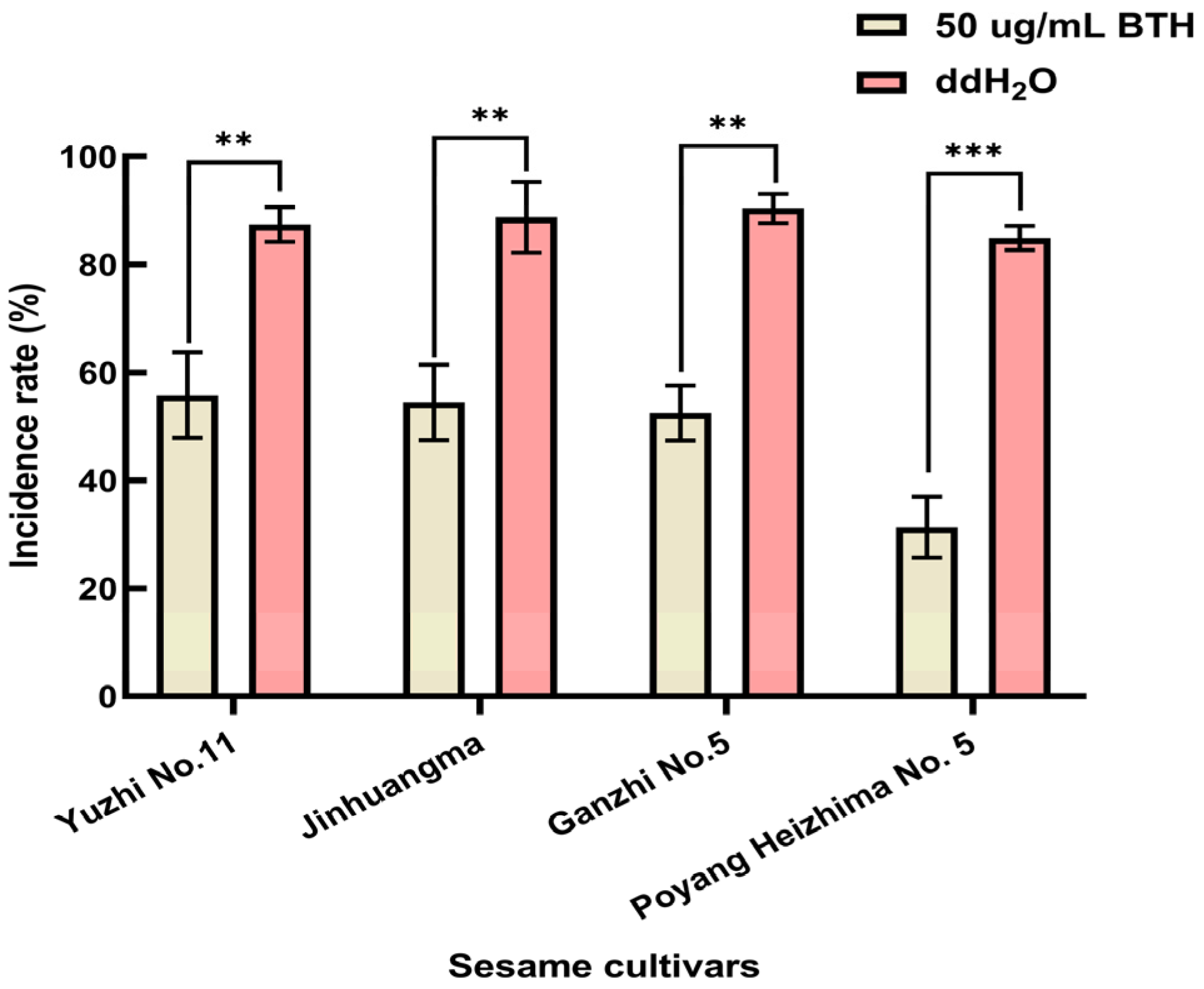
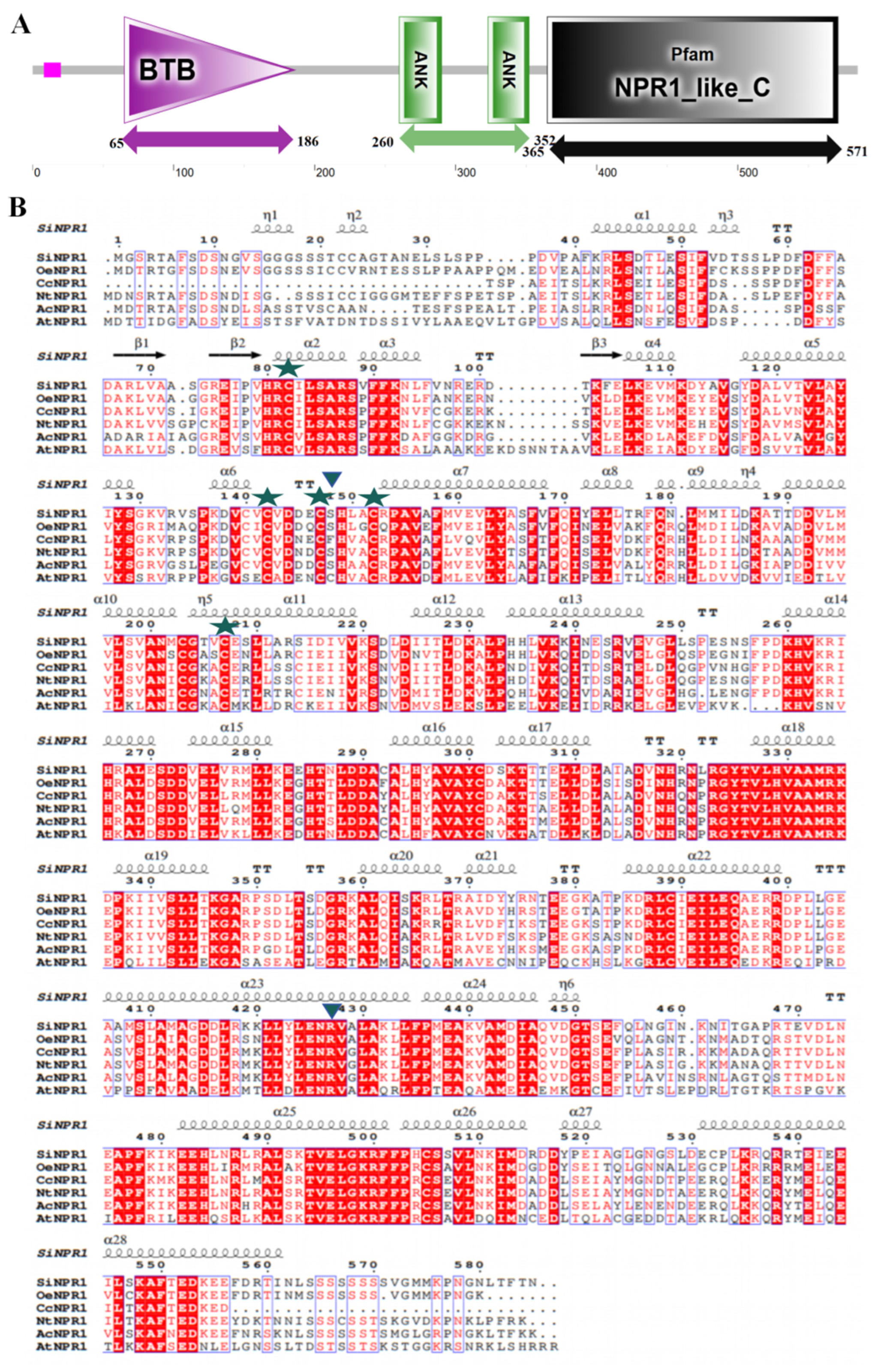


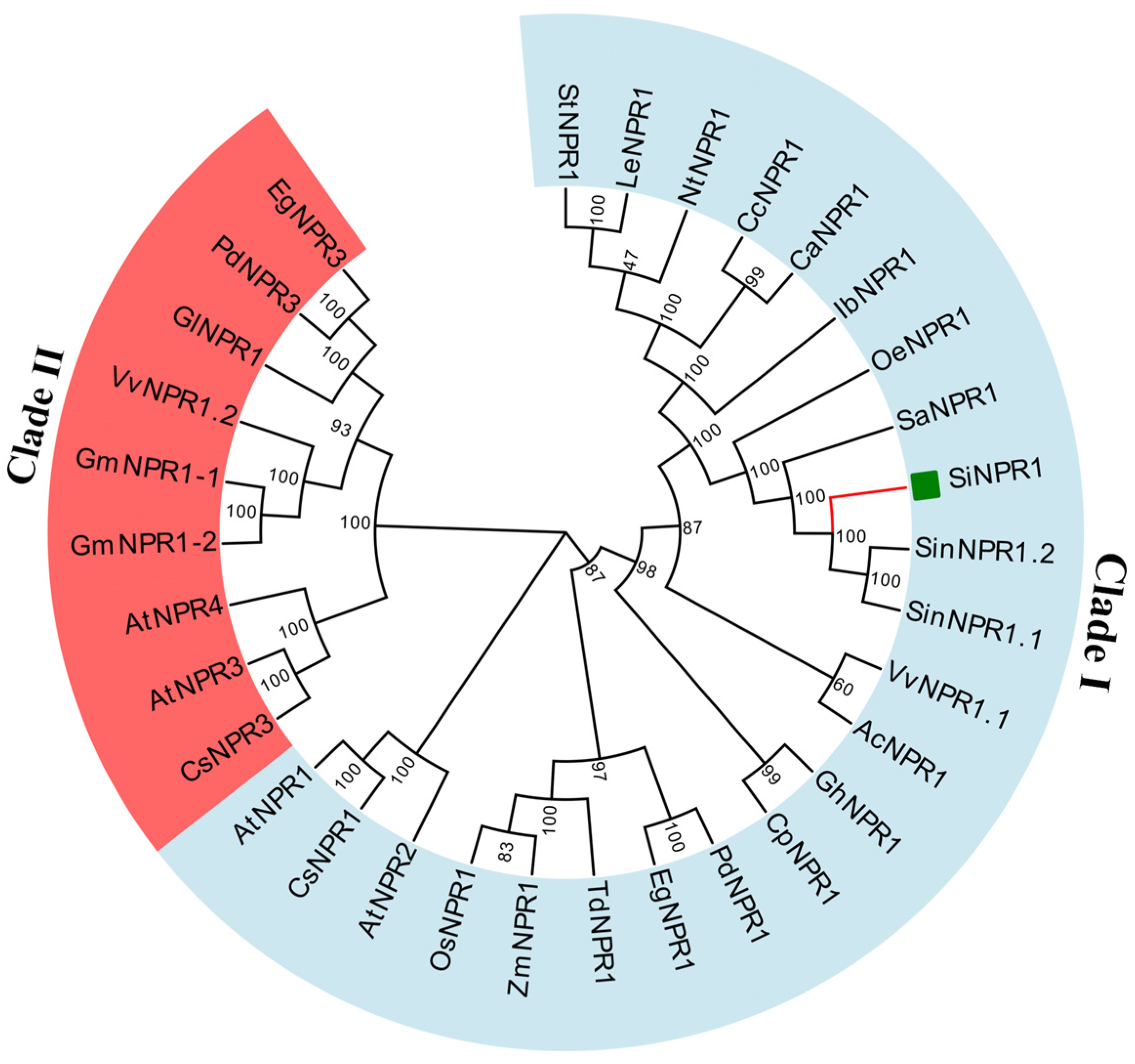
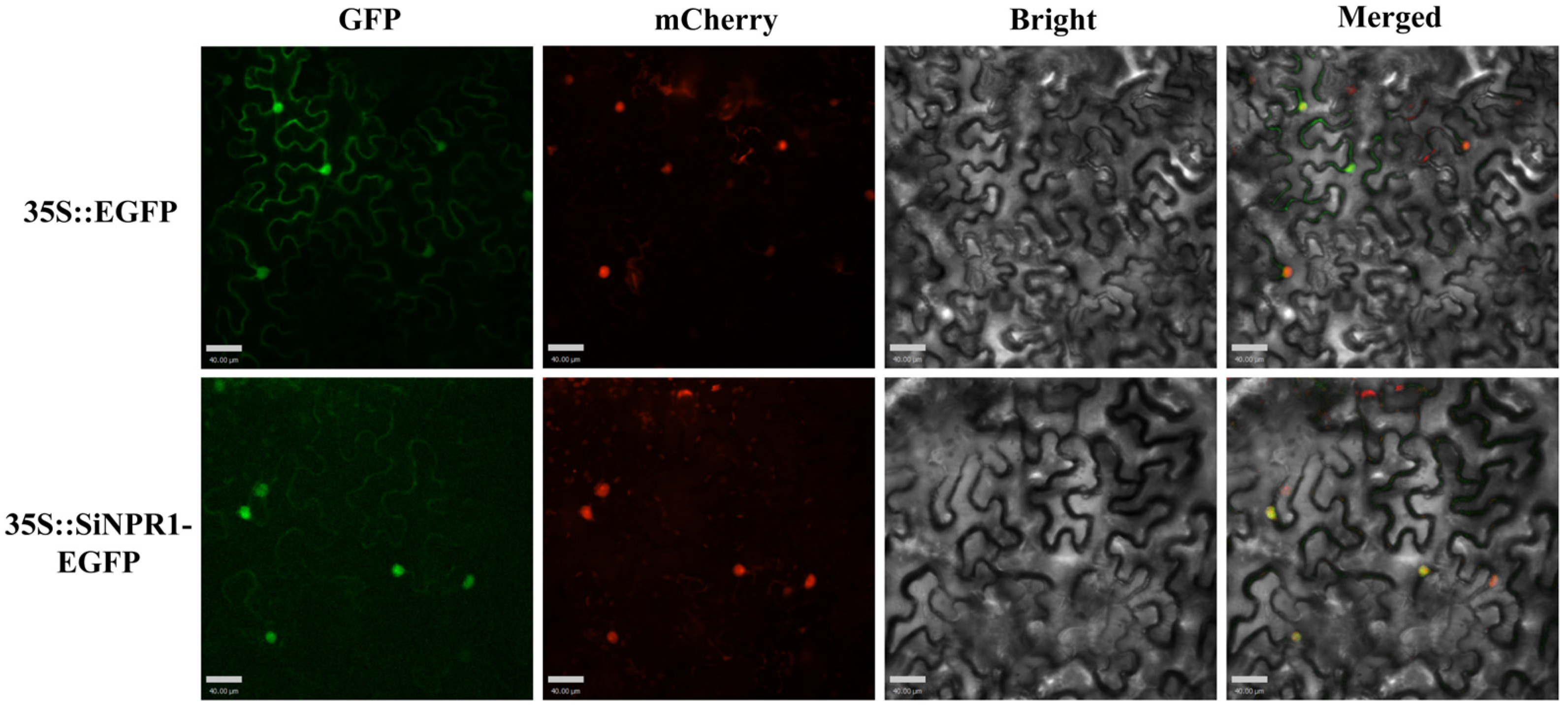

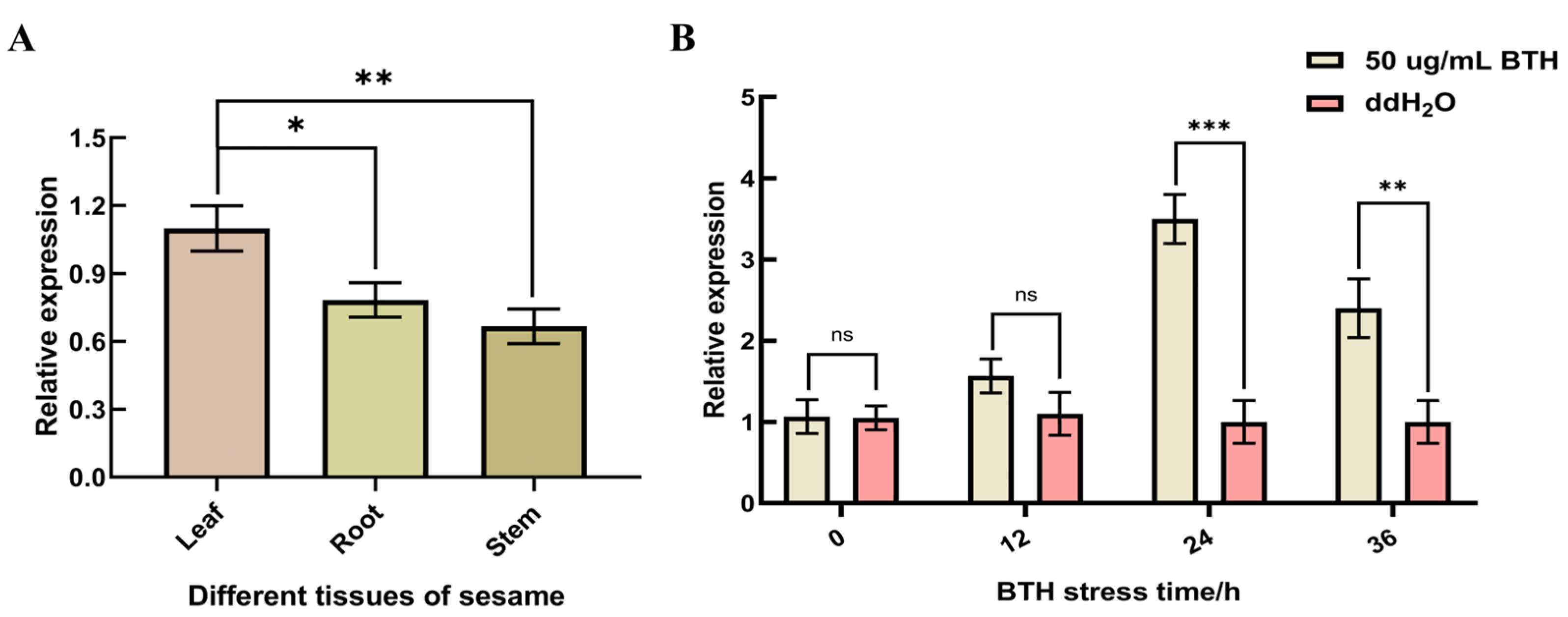

Disclaimer/Publisher’s Note: The statements, opinions and data contained in all publications are solely those of the individual author(s) and contributor(s) and not of MDPI and/or the editor(s). MDPI and/or the editor(s) disclaim responsibility for any injury to people or property resulting from any ideas, methods, instructions or products referred to in the content. |
© 2025 by the authors. Licensee MDPI, Basel, Switzerland. This article is an open access article distributed under the terms and conditions of the Creative Commons Attribution (CC BY) license (https://creativecommons.org/licenses/by/4.0/).
Share and Cite
Yan, M.; Zhao, X.; Li, X.; He, Z.; Hua, J.; Wei, L.; Sun, Y.; Wan, C.; Huang, S. Molecular Cloning, Bioinformatics, and Expression Analysis of the NPR1 Homolog in Sesame (Sesamum indicum L.). Plants 2025, 14, 3557. https://doi.org/10.3390/plants14233557
Yan M, Zhao X, Li X, He Z, Hua J, Wei L, Sun Y, Wan C, Huang S. Molecular Cloning, Bioinformatics, and Expression Analysis of the NPR1 Homolog in Sesame (Sesamum indicum L.). Plants. 2025; 14(23):3557. https://doi.org/10.3390/plants14233557
Chicago/Turabian StyleYan, Mingfeng, Xiaolin Zhao, Xingshen Li, Zhenrui He, Juling Hua, Lingen Wei, Yang Sun, Chuanxu Wan, and Shuijin Huang. 2025. "Molecular Cloning, Bioinformatics, and Expression Analysis of the NPR1 Homolog in Sesame (Sesamum indicum L.)" Plants 14, no. 23: 3557. https://doi.org/10.3390/plants14233557
APA StyleYan, M., Zhao, X., Li, X., He, Z., Hua, J., Wei, L., Sun, Y., Wan, C., & Huang, S. (2025). Molecular Cloning, Bioinformatics, and Expression Analysis of the NPR1 Homolog in Sesame (Sesamum indicum L.). Plants, 14(23), 3557. https://doi.org/10.3390/plants14233557





